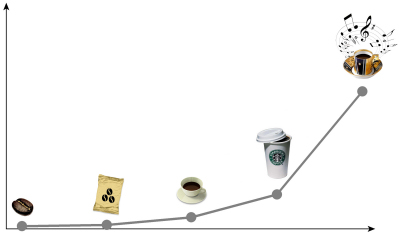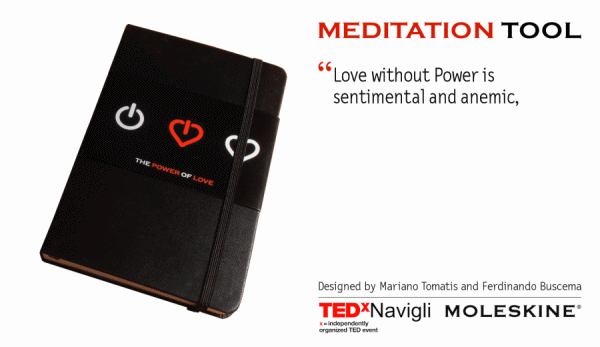MARIANO TOMATISWONDER INJECTORItalian writer and magician
|
 Magic & EconomyExperientializing goods with magic Posted on thursday 12 june 2014, 57 days before scifoo14 • Written by Mariano TomatisIn a society where products and services are more and more becoming alike, the ability to surprise a customer beyond any rational argument makes a difference. In this scenario, magic — and the surprise it evokes — may be a valuable marketing tool. To describe the idea behind it, in our book L’arte di stupire (“Amaze”) me and Ferdinando Buscema use the image of coffee proposed by Joseph Pine II and James Gilmore in The Experience Economy. The handful of beans necessary to make a cup of coffee cup, earn a farmer one or two cents. When the manufacturer grinds, packs and sells them in the supermarket, the cost of the coffee cup rises to about 25 cents. Served at the local bar, its cost reaches one dollar. However, when served in a luxurious environment — as in a theater or a renowned restaurant — it’s no surprise spending three dollars for a coffee. At the Cafe Florian in Venice, Italy a cup of coffee is inseparable from the playing orchestra — total cost: $15. The good sold is always the same, but the farmer offers it as a commodity, the supermarket as a consumer good, the bar as a service and the Venetian venue as a part of an experience. These four types of offers have different values in the customer experience.  Nowadays goods and services are no longer enough, and a new kind of offer emerged: that of the experiences, occurring whenever a company intentionally uses services as the stage and goods as props to engage an individual. In the “Experience Economy” (1), a company not only provides a good or a service, but also all of the feelings that come together with it. Shifting the focus from the product to the customer, companies seek to enhance the experience of the user, care for it and make sure it will remain in memory. Minting a new effective verb, Pine and Gilmore wrote that manufacturers must explicitly design their goods to enhance the user’s experience as well — essentially experientializing the goods. (2) But what does that mean in practice? Our work for Moleskine In March 2013 we organized the event TEDxNavigli “The Power of Love”, focused on the implications of love in art, business and society at large. For such occasion, the company Moleskine involved us in the design of a notebook to be in theme with the event. Using the rubberband that keeps the notebook closed, we hacked the object, adding an unexpected function. Reflecting on the quote by Martin Luther King Love without Power is sentimental and anemic we printed on the cover three logos: on the two ends, the “power” icon and a “heart” icon (standing for “love”), in the middle, a hybrid icon that ideally put them together.  At rest, the rubberband is positioned on the heart. To move the rubberband on the power icon it requires a remarkable strenght of a finger. With less effort, you can keep the band on the central symbol, getting the right mix of power and love.  As written on the inner band of the Moleskine notebook, across science and magic: To keep the elastic band on the central symbol you need a force of 1.618 Newtons. That number is the Golden Ratio, an ideal of harmony and the principle of natural and artistic phenomena. By incorporating this universal constant, this Moleskine notebook will allow you to reflect on the Power of Love — a pillar of the harmony of the spheres since time immemorial. This is just one way to “experientialize” a good. In order to add an unexpected function to an object it is necessary to create an original story that involves an unusual detail. Combined with the curious cover art, the Moleskine elastic band turns the notebook into a “tool for meditation” (see it in the official blog). On several occasions we’ve been asked if, in principle, it is possible to turn any object into a magical one. Paraphrasing Douglas Hofstadter, one can not be so arrogant to say yes, but we trust in the possibility — starting from any object — to identify an unexpected and surprising angle from which to look at it, making something magical happen. Using magic to discourage consumerism Besides being a marketing tool, like a knife cutting both ways, magic can be used in the opposite direction. Are you horrified (like me) by people camping at night in front of big stores, to be the first who will buy the brand new mobile phone next morning? Enjoy the incredible experience designed by Improv Everywhere involving the owner of a 99 cent store in Manhattan. A truly subversive (and magical) poetry! _________________ (1) The term was firstly proposed in Pine II, B. Joseph e Gilmore, James H., “Welcome to the Experience Economy”, Harvard Business Review, July/August 1998, pp. 97-105. (2) Joseph B. Pine II and James H. Gilmore, The Experience Economy, Harvard Business Press, 2011. You could be interested also in:
|
 Science Foo Camp (or “Sci Foo”) is an invitation-only gathering organized by Digital Science, O'Reilly Media, and Google, with support from Nature. The 9th edition of Sci Foo takes place on 8-10 August 2014 at the Googleplex in Mountain View, CA. Lord Martin Rees has defined it as “a sort of mini Woodstock of the Mind”. Participants include researchers, writers, educators, artists, policy makers, investors, and other thought leaders, all doing groundbreaking work in diverse areas of science and technology.
Science Foo Camp (or “Sci Foo”) is an invitation-only gathering organized by Digital Science, O'Reilly Media, and Google, with support from Nature. The 9th edition of Sci Foo takes place on 8-10 August 2014 at the Googleplex in Mountain View, CA. Lord Martin Rees has defined it as “a sort of mini Woodstock of the Mind”. Participants include researchers, writers, educators, artists, policy makers, investors, and other thought leaders, all doing groundbreaking work in diverse areas of science and technology.